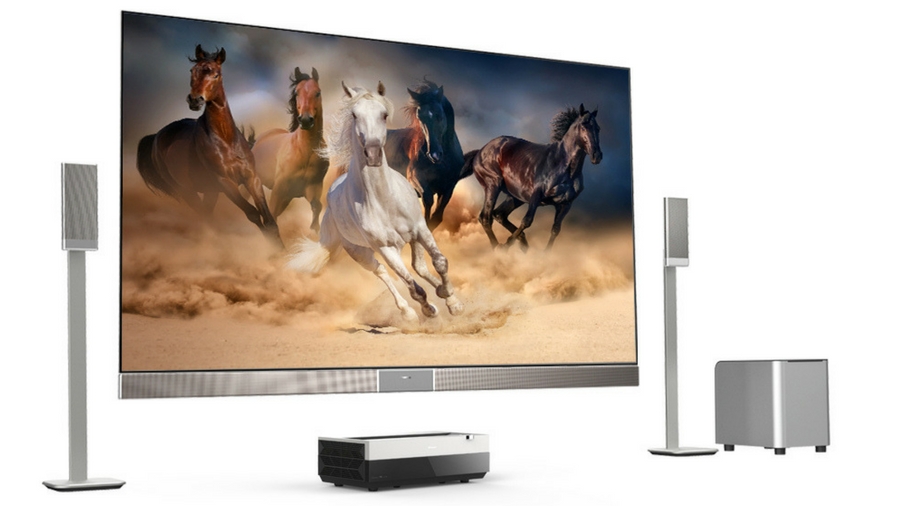Is the future of 4K TV completely panel-less?
There’s a good chance the next 4K image you see will come from a projector

My TV is bigger than your TV. That's always the thrust of consumer electronics exhibitions, and CES 2017 was no different, with 100-inch+ TVs all over the place. Except that this year one manufacturer – while also making the usual bigger-is-better argument – came to a completely different conclusion.
“The future of television is panel-less,” says Amy Lessig, National Training and Execution Manager at Hisense.
She was talking about Hisense’s 100H10D, a laser TV being shown-off at CES 2017, but it’s really a projection system. It’s a short-throw model capable of projecting onto a wall from barely 13 inches away, it deals in 4K Ultra HD resolution, and it creates images as big as 100-inches in diameter.
“We think it’s going to be the future of television.”
Lessig might have a point here. But are people really ready to ditch screens for projectors?

At its most basic, the Hisense 100H10D is merely an update on previous concepts; last year the Chinese company showed-off a 100-inch Full HD laser TV.
However, this 4K version is confirmed to go on sale in the US in 2017.
Sign up for breaking news, reviews, opinion, top tech deals, and more.
“This technology allows you to place the laser projector on a table about 24 inches from the wall,” says Lessig. However, 24-inches is the maximum; the 100H10D can actually be placed a lot nearer to the wall, about 13-inches to be precise. So what about audio? This is where many similar projection concepts fall over – nobody wants a mess of cables in their living room.
“It includes 5.1 audio,” confirms Lessig. The left, right and centre channels are delivered purely through a soundbar that stretches right across the bottom of the 100-inch projection area that, naturally, can be wall-mounted. “Rears are wireless, as is the subwoofer, which makes it very easy to move around the room,” says Lessig.
Projectors 1, TVs 0.

The 100H10D also deals in 4K Ultra HD 3840x2160 pixels resolution. Of course it does. It has to. But it also has HDR.
“We’re very excited about its HDR 10 compatibility and wide color gamut technology – users will see a nice throw of colour,” says Lessig.
The 100H10D also boasts Ultra HD upscaling and 120Hz motion processing. The product itself also has three HDMI inputs, three USB slots, digital audio out, a headphones jack, VGA and composite. Although it suggests a panel-less future, at its core the concept of a laser TV is still about screen size. It’s also about price.
“In comparison to a big TV of this size you would be looking at about $25,000-30,000,” says Lessig, who points out that other projection systems similar to Hisense’s cost $50,000. She’s referring to Sony’s LSPX-W1S 4K ultra short-throw projector – the only other such product on the market – which does indeed sell for precisely $50,000.
So how much is the 100H10D? Hisense’s effort will cost ‘just’ $12,999.99 when it launches in the US in summer 2017.

Sony’s effort can manage a 147-inch image from even closer to the wall and is best put on the floor rather than on a table. Although Hisense’s 100H10D is far cheaper, it could also find a challenger closer to home.
“Another Chinese vendor ChangHong has also been making short-throw products,” says David Tett, Market Analyst at Futuresource. “It’s a phenomenon that started in China because of the inability of some people to hang a 65-inch TV on the wall for structural reasons, so it addresses that.”
Does that mean the world is willing ditch TVs entirely? That might not be the best thing for Hisense, considering it’s China's largest TV manufacturer in terms of sales volume. The answer? Probably not.
“It’s in direct competition to a 65-inch or larger screen, but these projection systems are still relatively very pricey,” says Tett. “You can buy a 65-inch OLED TV for less than half the price.”

LG also showed-off a similar laser screen product at CES 2013; LG’s Hecto projected a 100-inch Full HD image from 22-inches, and sold for $19,999. Are concepts like these really the future of television, or a sideshow to the trend of ever-growing TVs?
Tett calls the market for 4K short-throw projection systems a “niche within a niche” that’s likely to stay that way, largely because 2017 will see a step-in TV panel production globally, but also because projectors are generally a hard sell.
“Sales of projectors in electronics retail stores have remained limited,” says his colleague Jack Wetherill, Senior Market Analyst at Futuresource Consulting, though he notes that e-commerce sales are increasing. “The high cost of 4K projector models currently limits sales mostly to the custom-install channel, but developments in chip-set and light-source technology could see such solutions becoming relatively affordable in a few years.”

Even Lessig admits that Hisense is going after a niche market. “It’s a go-getter for people with new custom-built homes and new constructions that are looking for the big TV option,” she says, stressing the ease of set-up.
“Since it goes on a table, you don't need a ceiling mount, so you don’t need professional installation.” However, there is the small matter of the screen. “We’re looking at several manufacturers to come up with a solution that provides the best picture quality,” says Lessig, though she confirms that a screen will be included in the price.
However, for now the TV industry is becoming increasingly focused on OLED and its technical possibilities. While not exactly panel-less, LG’s paper-thin W-Series OLED TVs are just 1 mm thin and flexible – making them a nice compromise between traditional larger LCD screens and projectors.
So what do we think the future of TV will entail? It’s probably not huge panels, or pricey projectors, but something in between.
Want a 4K projector right now? Check out our reviews of the Sony VPL-VW300ES and Sony VPL-VW520ES.

Jamie is a freelance tech, travel and space journalist based in the UK. He’s been writing regularly for Techradar since it was launched in 2008 and also writes regularly for Forbes, The Telegraph, the South China Morning Post, Sky & Telescope and the Sky At Night magazine as well as other Future titles T3, Digital Camera World, All About Space and Space.com. He also edits two of his own websites, TravGear.com and WhenIsTheNextEclipse.com that reflect his obsession with travel gear and solar eclipse travel. He is the author of A Stargazing Program For Beginners (Springer, 2015),